[English] 日本語
 Yorodumi
Yorodumi- PDB-1kj2: Murine Alloreactive ScFv TCR-Peptide-MHC Class I Molecule Complex -
+ Open data
Open data
- Basic information
Basic information
| Entry | Database: PDB / ID: 1kj2 | |||||||||
|---|---|---|---|---|---|---|---|---|---|---|
| Title | Murine Alloreactive ScFv TCR-Peptide-MHC Class I Molecule Complex | |||||||||
 Components Components |
| |||||||||
 Keywords Keywords | IMMUNE SYSTEM / T CELL RECEPTOR / CLASS I MHC / H-2KB / TCR-PMHC COMPLEX / ALLOGENEIC | |||||||||
| Function / homology |  Function and homology information Function and homology informationalpha-aminoacyl-tRNA binding / cytoplasmic exosome (RNase complex) / positive regulation of mRNA catabolic process / Endosomal/Vacuolar pathway / DAP12 interactions / Antigen Presentation: Folding, assembly and peptide loading of class I MHC / ER-Phagosome pathway / GTP metabolic process / DAP12 signaling / Immunoregulatory interactions between a Lymphoid and a non-Lymphoid cell ...alpha-aminoacyl-tRNA binding / cytoplasmic exosome (RNase complex) / positive regulation of mRNA catabolic process / Endosomal/Vacuolar pathway / DAP12 interactions / Antigen Presentation: Folding, assembly and peptide loading of class I MHC / ER-Phagosome pathway / GTP metabolic process / DAP12 signaling / Immunoregulatory interactions between a Lymphoid and a non-Lymphoid cell / T cell receptor complex / antigen processing and presentation of exogenous peptide antigen via MHC class I / inner ear development / antigen processing and presentation of endogenous peptide antigen via MHC class I via ER pathway, TAP-dependent / cellular defense response / translation elongation factor activity / Neutrophil degranulation / lumenal side of endoplasmic reticulum membrane / cellular response to iron(III) ion / negative regulation of forebrain neuron differentiation / antigen processing and presentation of exogenous protein antigen via MHC class Ib, TAP-dependent / iron ion transport / peptide antigen assembly with MHC class I protein complex / regulation of iron ion transport / regulation of erythrocyte differentiation / HFE-transferrin receptor complex / response to molecule of bacterial origin / MHC class I peptide loading complex / T cell mediated cytotoxicity / positive regulation of T cell cytokine production / antigen processing and presentation of endogenous peptide antigen via MHC class I / MHC class I protein complex / peptide antigen binding / positive regulation of receptor-mediated endocytosis / negative regulation of neurogenesis / cellular response to nicotine / positive regulation of T cell mediated cytotoxicity / multicellular organismal-level iron ion homeostasis / phagocytic vesicle membrane / negative regulation of epithelial cell proliferation / sensory perception of smell / positive regulation of cellular senescence / T cell differentiation in thymus / negative regulation of neuron projection development / protein refolding / protein homotetramerization / amyloid fibril formation / adaptive immune response / intracellular iron ion homeostasis / cytoplasmic translation / learning or memory / tRNA binding / defense response to bacterium / external side of plasma membrane / GTPase activity / GTP binding / structural molecule activity / Golgi apparatus / protein homodimerization activity / extracellular space / cytosol Similarity search - Function | |||||||||
| Biological species |  | |||||||||
| Method |  X-RAY DIFFRACTION / X-RAY DIFFRACTION /  SYNCHROTRON / SYNCHROTRON /  MOLECULAR REPLACEMENT / Resolution: 2.71 Å MOLECULAR REPLACEMENT / Resolution: 2.71 Å | |||||||||
 Authors Authors | Reiser, J.-B. / Gregoire, C. / Darnault, C. / Mosser, T. / Guimezanes, A. / Schmitt-Verhulst, A.-M. / Fontecilla-Camps, J.C. / Mazza, G. / Malissen, B. / Housset, D. | |||||||||
 Citation Citation |  Journal: Immunity / Year: 2002 Journal: Immunity / Year: 2002Title: A T cell receptor CDR3beta loop undergoes conformational changes of unprecedented magnitude upon binding to a peptide/MHC class I complex. Authors: Reiser, J.B. / Gregoire, C. / Darnault, C. / Mosser, T. / Guimezanes, A. / Schmitt-Verhulst, A.M. / Fontecilla-Camps, J.C. / Mazza, G. / Malissen, B. / Housset, D. #1:  Journal: Embo J. / Year: 1997 Journal: Embo J. / Year: 1997Title: The three-dimentional structure of a T-cell antigen receptor ValphaVbeta heterodimer reveals a novel arrangement of the Vbeta domain Authors: Housset, D. / Mazza, G. / Gregoire, C. / Piras, C. / Malissen, B. / Fontecilla-Camps, J.C. #2:  Journal: NAT.IMMUNOL. / Year: 2000 Journal: NAT.IMMUNOL. / Year: 2000Title: CRYSTAL STRUCTURE OF A T CELL RECEPTOR BOUND TO AN ALLOGENIC MHC MOLECULE Authors: Reiser, J.-B. / Darnault, C. / Guimezanes, A. / Gregoire, C. / Mosser, T. / Schmitt-Verhulst, A.-M. / Fontecilla-Camps, J.C. / Malissen, B. / Housset, D. / Mazza, G. #3:  Journal: EUR.J.IMMUNOL. / Year: 2001 Journal: EUR.J.IMMUNOL. / Year: 2001Title: IDENTIFICATION OF ENDOGENEOUS PEPTIDES RECOGNIZED BU IN VIVO OR IN VITRO GENERATED ALLOREACTIVE CTL: DISTINCT CHARACTERISTICS CORRELATED WITH CD8-DEPENDENCE Authors: Guimezanes, A. / Barret-Wilt, G. / Gulden-Thompson, P. / Shabanowitz, J. / Hunt, D. / Schmitt-Verhulst, A.-M. | |||||||||
| History |
|
- Structure visualization
Structure visualization
| Structure viewer | Molecule:  Molmil Molmil Jmol/JSmol Jmol/JSmol |
|---|
- Downloads & links
Downloads & links
- Download
Download
| PDBx/mmCIF format |  1kj2.cif.gz 1kj2.cif.gz | 263.7 KB | Display |  PDBx/mmCIF format PDBx/mmCIF format |
|---|---|---|---|---|
| PDB format |  pdb1kj2.ent.gz pdb1kj2.ent.gz | 211 KB | Display |  PDB format PDB format |
| PDBx/mmJSON format |  1kj2.json.gz 1kj2.json.gz | Tree view |  PDBx/mmJSON format PDBx/mmJSON format | |
| Others |  Other downloads Other downloads |
-Validation report
| Summary document |  1kj2_validation.pdf.gz 1kj2_validation.pdf.gz | 912.9 KB | Display |  wwPDB validaton report wwPDB validaton report |
|---|---|---|---|---|
| Full document |  1kj2_full_validation.pdf.gz 1kj2_full_validation.pdf.gz | 965.7 KB | Display | |
| Data in XML |  1kj2_validation.xml.gz 1kj2_validation.xml.gz | 51.4 KB | Display | |
| Data in CIF |  1kj2_validation.cif.gz 1kj2_validation.cif.gz | 70.5 KB | Display | |
| Arichive directory |  https://data.pdbj.org/pub/pdb/validation_reports/kj/1kj2 https://data.pdbj.org/pub/pdb/validation_reports/kj/1kj2 ftp://data.pdbj.org/pub/pdb/validation_reports/kj/1kj2 ftp://data.pdbj.org/pub/pdb/validation_reports/kj/1kj2 | HTTPS FTP |
-Related structure data
| Related structure data |  1kj3SC 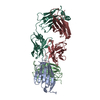 1kb5S S: Starting model for refinement C: citing same article ( |
|---|---|
| Similar structure data |
- Links
Links
- Assembly
Assembly
| Deposited unit | 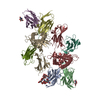
| ||||||||
|---|---|---|---|---|---|---|---|---|---|
| 1 | 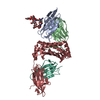
| ||||||||
| 2 | 
| ||||||||
| Unit cell |
|
- Components
Components
-Protein , 2 types, 4 molecules HILM
| #1: Protein | Mass: 31971.664 Da / Num. of mol.: 2 / Fragment: Extracellular domains (alpha1, alpha2, alpha3) Source method: isolated from a genetically manipulated source Source: (gene. exp.)   #3: Protein | Mass: 11704.359 Da / Num. of mol.: 2 Source method: isolated from a genetically manipulated source Source: (gene. exp.)   |
|---|
-KB5-C20 T-Cell receptor ... , 2 types, 4 molecules ADBE
| #4: Protein | Mass: 12478.844 Da / Num. of mol.: 2 / Fragment: Fv fragment , variable domain Source method: isolated from a genetically manipulated source Source: (gene. exp.)    Keywords: www / References: GenBank: 554285 Keywords: www / References: GenBank: 554285#5: Protein | Mass: 13381.247 Da / Num. of mol.: 2 / Fragment: Fv fragment , variable domain Source method: isolated from a genetically manipulated source Source: (gene. exp.)   |
|---|
-Protein/peptide / Non-polymers , 2 types, 93 molecules PQ

| #2: Protein/peptide | Mass: 949.165 Da / Num. of mol.: 2 / Source method: obtained synthetically / Details: SEQUENCE NATURALLY OCCURS IN MUS MUCULUS / References: UniProt: O08582 #8: Water | ChemComp-HOH / | |
|---|
-Sugars , 2 types, 3 molecules 
| #6: Polysaccharide | N-acetyl-alpha-neuraminic acid-(2-3)-beta-D-galactopyranose-(1-4)-2-acetamido-2-deoxy-beta-D- ...N-acetyl-alpha-neuraminic acid-(2-3)-beta-D-galactopyranose-(1-4)-2-acetamido-2-deoxy-beta-D-glucopyranose-(1-2)-alpha-D-mannopyranose-(1-6)-[alpha-D-mannopyranose-(1-3)]alpha-D-mannopyranose-(1-4)-2-acetamido-2-deoxy-beta-D-glucopyranose-(1-4)-2-acetamido-2-deoxy-beta-D-glucopyranose Source method: isolated from a genetically manipulated source |
|---|---|
| #7: Sugar |
-Details
| Has protein modification | Y |
|---|
-Experimental details
-Experiment
| Experiment | Method:  X-RAY DIFFRACTION / Number of used crystals: 1 X-RAY DIFFRACTION / Number of used crystals: 1 |
|---|
- Sample preparation
Sample preparation
| Crystal | Density Matthews: 3.11 Å3/Da / Density % sol: 60.47 % | ||||||||||||||||||||||||||||||||||||||||||
|---|---|---|---|---|---|---|---|---|---|---|---|---|---|---|---|---|---|---|---|---|---|---|---|---|---|---|---|---|---|---|---|---|---|---|---|---|---|---|---|---|---|---|---|
| Crystal grow | Temperature: 277 K / Method: vapor diffusion, hanging drop / pH: 6.7 Details: 17-19% PEG 6000, 0.1M Mes, 0.1M NaCl, 0.1M MgAc, pH 6.7, VAPOR DIFFUSION, HANGING DROP, temperature 277K | ||||||||||||||||||||||||||||||||||||||||||
| Crystal grow | *PLUS Temperature: 20 ℃ | ||||||||||||||||||||||||||||||||||||||||||
| Components of the solutions | *PLUS
|
-Data collection
| Diffraction | Mean temperature: 110 K |
|---|---|
| Diffraction source | Source:  SYNCHROTRON / Site: SYNCHROTRON / Site:  ESRF ESRF  / Beamline: BM30A / Wavelength: 0.987 Å / Beamline: BM30A / Wavelength: 0.987 Å |
| Detector | Type: MARRESEARCH / Detector: IMAGE PLATE / Date: Feb 19, 2000 |
| Radiation | Protocol: SINGLE WAVELENGTH / Monochromatic (M) / Laue (L): M / Scattering type: x-ray |
| Radiation wavelength | Wavelength: 0.987 Å / Relative weight: 1 |
| Reflection | Resolution: 2.71→14.99 Å / Num. all: 45992 / Num. obs: 45992 / % possible obs: 96.9 % / Observed criterion σ(F): 0 / Observed criterion σ(I): 0 / Redundancy: 3.4 % / Biso Wilson estimate: 55.9 Å2 / Rsym value: 0.084 / Net I/σ(I): 7.7 |
| Reflection shell | Resolution: 2.71→2.85 Å / Redundancy: 2.8 % / Mean I/σ(I) obs: 2 / Num. unique all: 4916 / Rsym value: 0.382 / % possible all: 87.8 |
| Reflection | *PLUS Highest resolution: 2.7 Å / Rmerge(I) obs: 0.084 |
- Processing
Processing
| Software |
| ||||||||||||||||||||||||||||||||||||
|---|---|---|---|---|---|---|---|---|---|---|---|---|---|---|---|---|---|---|---|---|---|---|---|---|---|---|---|---|---|---|---|---|---|---|---|---|---|
| Refinement | Method to determine structure:  MOLECULAR REPLACEMENT MOLECULAR REPLACEMENTStarting model: 1KB5, 1KJ3 Resolution: 2.71→12 Å / Isotropic thermal model: Isotropic / Cross valid method: THROUGHOUT / σ(F): 0 / σ(I): 0 / Stereochemistry target values: Engh & Huber Details: The work R and Free R values correspond to the ones calulated in the last cycle of maximum likelihood refinement. Due to the resolution limit of our structure (2.7), The refinement has been ...Details: The work R and Free R values correspond to the ones calulated in the last cycle of maximum likelihood refinement. Due to the resolution limit of our structure (2.7), The refinement has been ended by few cycles of least-square method including all reflexions. So both distinct algorithms and the including of Free set in refinement can make the convergence a little different.
| ||||||||||||||||||||||||||||||||||||
| Solvent computation | Bsol: 26.56 Å2 / ksol: 0.31 e/Å3 | ||||||||||||||||||||||||||||||||||||
| Displacement parameters | Biso mean: 45.65 Å2
| ||||||||||||||||||||||||||||||||||||
| Refinement step | Cycle: LAST / Resolution: 2.71→12 Å
| ||||||||||||||||||||||||||||||||||||
| Refine LS restraints |
| ||||||||||||||||||||||||||||||||||||
| LS refinement shell | Resolution: 2.71→2.81 Å
| ||||||||||||||||||||||||||||||||||||
| Refinement | *PLUS % reflection Rfree: 10 % / Rfactor Rwork: 0.22 | ||||||||||||||||||||||||||||||||||||
| Solvent computation | *PLUS | ||||||||||||||||||||||||||||||||||||
| Displacement parameters | *PLUS | ||||||||||||||||||||||||||||||||||||
| Refine LS restraints | *PLUS
| ||||||||||||||||||||||||||||||||||||
| LS refinement shell | *PLUS Rfactor obs: 0.362 |
 Movie
Movie Controller
Controller


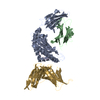

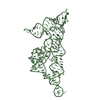



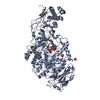
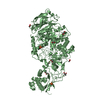
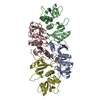
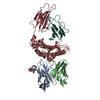
 PDBj
PDBj















